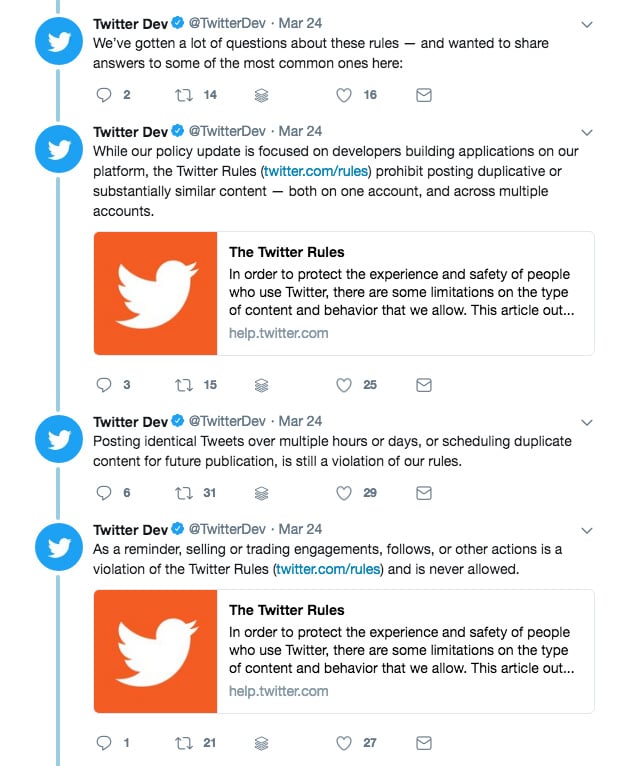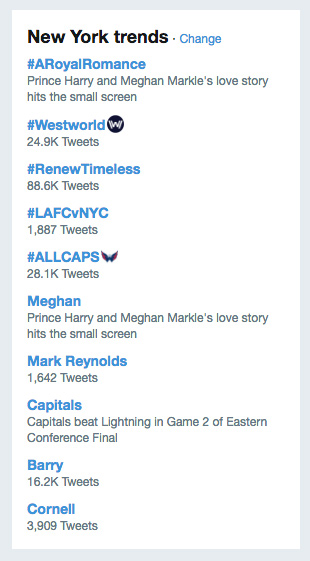Twitter has long been a go-to platform for spreading perfectly useful information via social media automation. But it’s also fallen prey to spammy bots and hashtags, fake profiles, bullying, and, alarmingly, malicious users trying to destabilize the democratic process in other countries.
It’s a move that’s getting a lot of support, even as it causes a bit of uncertainty in digital marketing circles.
The rules place limitations on what users can do via social media automation tools, so if you’ve ever scheduled a tweet, it’s important that you understand how the changes apply to you – ignoring them could result in Twitter suspending your account.
In this post, I’ll walk through the changes to Twitter’s terms of services, what they mean for social media automation, and how your brand can still thrive under the new rules.
Are you prepared for Twitter’s changes to social media automation?
If you’re engaged in social media automation and scheduling, you might not be immediately concerned. Your content is good content. So what do you have to worry about?
It depends on how social media automation informs your digital marketing strategy.
The truth is that this latest round of policy updates have forced some social media scheduling platforms to make changes – both subtle and significant – to their platforms. And that means you, as a digital marketer, need to be prepared to adapt.
If you do things right, you’ll likely never notice the latest Twitter terms of service update. But doing things incorrectly could get your Twitter account flagged, suspended, or banned – and that could be disastrous for you and your brand.
What are Twitter’s new rules?
At first glance, Twitter’s new rules are pretty straightforward and non-intrusive, even if you have come to rely heavily on social media automation and scheduling. However, it’s important to take these rules seriously and act accordingly.
- Limitations on recycling Tweets – no duplicate content is allowed, even on the same account
- The same content can no longer be posted across multiple accounts
- Simultaneous or bulk actions are also no longer allowed; for example, liking all Tweets with your brand name in it simultaneously could be viewed as spammy
- Posting exorbitant Tweets to a trending topic may also be viewed as negative behavior
The litmus test for compliance with these rules can be pretty simple when you think about it: Twitter wants you to add value to their platform.
So before you post any content, retweet a joke, or like a comment, you should ensure that it adds value to others’ lives and the general social media environment.

Why did Twitter introduce these new rules?
There’s an old saying about how a bad apple spoils the bunch. That’s essentially what prompted Twitter to introduce these new rules. There are several types of behaviors that they are intended to combat:
- Abusive behavior: Behavior intended to bully, intimidate, or otherwise abuse users.
- Spam: Content that is duplicative across multiple accounts in a non-organic way.
- Bots: Automated “bot” accounts that don’t belong to people; bots, rather, act on a set of pre-programmed instructions and often skew authentic interactions in a damaging way
Twitter has good reason to be concerned about many of the issues on the platform. Indeed, there are many who are concerned that Twitter’s new rules don’t go far enough and more changes might be coming. For now, however, it’s enough to acknowledge the core reasons behind Twitter’s moves so as to be better prepared for changes in the future as well.
How can I thrive under Twitter’s new rules?
Twitter’s new rules may force you to change some of your content and social media automation strategies. But they also offer a brand new opportunity for you the thrive. Following a few simple strategies can help your Twitter scheduling strategy and keep your social media automation use above board.
1. Make sure every Tweet is unique
Twitter’s new rules now take a dim view of repeated tweets. Your old strategy, for example, may have included multiple reminders of an important date. So, you may have tweeted something like, “Don’t forget, free coffee on May 29th!”
And that’s great. It used to be easy to simply copy and paste that tweet, automate those copies, and rest assured that your followers would have multiple reminders of your coffee giveaway promotion.
For example, here’s how The New York Times used to share content across its various Twitter accounts:

And here’s how the publication shares content to Twitter now:

Notice how The New York Times is sharing the same link but has provided a different description.
Under the new rules, the reminder and similar content strategies remains sound, but you need to make a few changes:
- Change up the word choice – Try not to repeat yourself word for word even if you’re presenting the same ideas again.
- You might be able to get away with retweeting your original Tweet, but don’t rely too heavily on this method (or use it too often)
- Make each and every tweet as unique as you possibly can. This will also help to make your feed more authentic
Automating tweets moving forward: You can still plan, compose, and schedule tweets in advance. You simply need to make sure that each and every tweet is unique.
2. Make sure your Twitter accounts are unique
One method that social media gurus formerly used with aplomb was the creation of multiple Twitter accounts to boost visibility and engagement. Unfortunately, under the new policies, these multiple accounts could get you and your business into trouble. And, if you do have multiple accounts, posting similar content to those accounts runs the risk of creating more problems.
There are a couple of strategies that can ensure you’re still putting good content out into the Twittersphere:
- Make sure all of your Twitter accounts are unique and have good reasons for being their own entities. If an account doesn’t offer value to Twitter’s users, it risks being categorized as spam.
- If you have multiple Twitter accounts, make sure they are all distributing unique content. You can no longer simply copy and paste messages across all of your accounts. Each new Tweet should be completely unique, original, and authentic.
Automating tweets moving forward: If your social media strategy previously relied on duplicated content, now is going to be a great time to reevaluate how you move forward. Making sure every single tweet is unique and that all of your accounts are valuable will only improve your performance and engagement over the long run.
3. Cut down on simultaneous actions
The lifeblood of Twitter – and all social media platforms, for that matter – is engagement. On Twitter, that means replies, likes, retweets and more (in addition to the original Tweet, of course).
Automation was previously used to make that simple. You could simply instruct your social media automation app to like all Tweets with #coffeelovers at 1pm every Friday.
Unfortunately, Twitter it know frowning upon that kind of mass, automated engagement. Instead, Twitter is favoring engagement that looks and feels more organic and authentic. The right way to engage followers now is to:
- Like individual tweets one at a time
- Replying to tweets one at a time
- Retweeting, with or without quotations, on an individual basis (although sometimes this can be scheduled ahead of time)
Automating tweets moving forward: You’re likely going to have to pay more attention to liking, replying, and retweeting on an organic basis, as well as the best times to post. Even with the best social media automation, scheduling the liking or or replying to Tweets is incredibly problematic. In this case, it’s best to simply honor what Twitter is asking and engage organically. You might even find that this type organic interaction ends up boosting engagement with your accounts.
4. Be careful with trending topics
One of Twitter’s most powerful and popular features is its list of trending topics. I’m not going to get into how those topics are compiled and listed because most social media marketing strategies aren’t trying to influence the trending topics, they’re trying to leverage them.
A common digital marketing strategy is simply to get your message in front of your audience. Trending topics is a great way to do that. Here’s what the Trending Topics sidebar looks like:

But some digital social media strategies have gone overboard, and now Twitter is cutting down on what it sees as spammy content. You might have to adjust your social media strategy by:
- Limiting the percentage of your tweets that are directly associated with trending topics
- Ensuring that you do not post to a trending topic more than is warranted or organic
- Taking the time to make sure that your tweet is related to the trending topic in content
Automating tweets moving forward: You’ll need to consider what trending topics you want to take advantage of ahead of time. Some trending topics are easy to predict, like #WednesdayWisdom, for example, or #MondayMotivation. You can still schedule some of those tweets ahead of time (just make sure you don’t over do it). The only drawback is that you might then have less opportunity to take advantage of spontaneous trending topics should that opportunity arise. You might also want to consider implementing Twitter Moments.
What are the consequences for violating the new rules?
Not all of Twitter’s new rules are all that novel. In some cases, they represent small changes from previously establish terms of service. In these cases, however, Twitter made one thing very clear: they are serious about enforcement.
Consequences for violation of Twitter’s new rules may result in:
- Twitter may decide you are spam: This could mean that Twitter automatically deletes some of your content or accounts.
- Your account may be suspended: In certain circumstances, Twitter could temporarily suspend any number of your accounts. This suspension can last anywhere from a few days to a few weeks depending on the infraction.
- Your Twitter account might be banned: In the most extreme circumstances, your Twitter account could be banned for violating Twitter’s terms of service. This would result in the permanent loss of a given account (or all accounts linked to a particular user). Clearly, this would not be a desired outcome if you are responsible for your brand’s social media accounts.
None of these consequences are exactly new. But Twitter seems more willingly to use them when necessary. There is an appeal process if you feel the platform has unfairly targeted your content, but it’s best to avoid that altogether where possible and ensure you’re following Twitter’s new rules to a tee.
It all comes down to quality content
Whether your social media strategy is entirely organic or you’ve developed a robust social media automation program, the core takeaway from these Twitter rule updates is the same: make sure you are creating quality content.
With Twitter’s new rules in place, you’ll need to make sure that each and every tweet that you send out actually delivers value to your followers. When using social media scheduling, there are a few ways to make sure that still happens:
- Make sure every tweet is original and organic – Have a reason for tweeting what you’re tweeting.
- Retweet, like, and reply organically and manually in order to ensure the best possible result. It’s not unusual for digital marketers and social media managers to spend more time on this particular task than any other.
- Use multiple Twitter accounts only where appropriate for the use case.
- Tweet about trending topics only when appropriate and when it fits with your digital content strategy.
So… Can I still schedule my Tweets via social media automation?
It’s important to emphasize that social media automation isn’t going anywhere. In fact, it’s likely that automation and scheduling will be more important than ever. If you’re spending a little more time engaging manually (and more fruitfully), you’ll want to automate as much of the rest of the process as possible.
So don’t worry, Twitter isn’t going to penalize you for scheduling your tweets! But that doesn’t mean some things won’t change. You will need to think more strategically about your social media automation rather than simply setting it up once and forgetting about it.
Think of these changes as an opportunity. Organic engagement has been tough for brand’s up until now because it was easy to be lost in the noise of countless bots shouting competitors’ messages. But the new, improved Twitter is an even playing field. So your organic, authentic engagement is much more likely to be noticed – and rewarded.
Twitter’s new rules = a better Twittersphere
Learn to play by Twitter’s new rules and your #socialmedia automation strategy will yield more engagement, stronger growth, and a better ROI
Click To Tweet
The post What Twitter’s New Rules Mean for Social Media Automation appeared first on Revive Social.